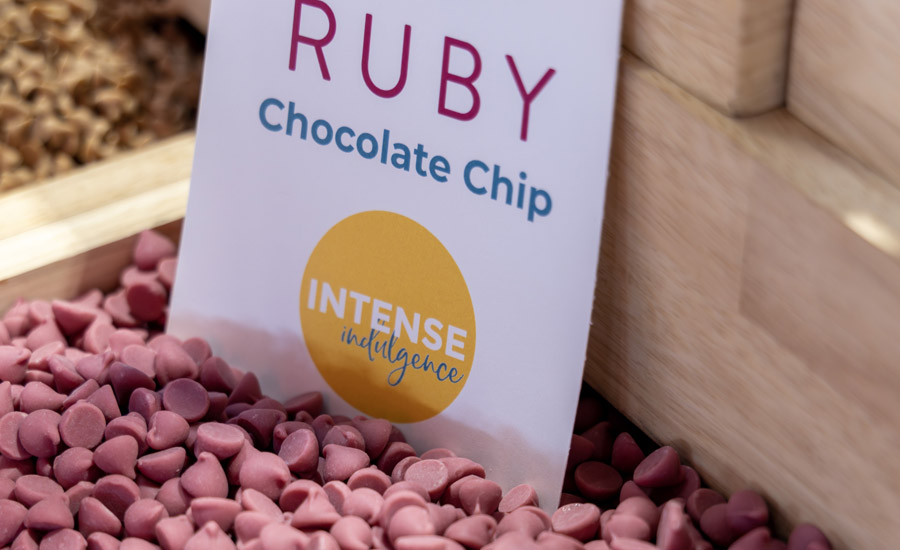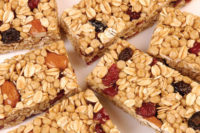Nearly everyone eats chocolate. Based on Statistia data, approximately 271 million Americans consumed chocolate and other candy in 2020; that’s more than 80% of the U.S. population. What’s more, there is something for everyone. With consumers looking for better-for-you options, manufacturers offer healthy indulgent chocolate choices; for those interested in straight-up indulgence, those options are out there, too.
Cargill recently completed its proprietary ChocoLogic survey, which offers a snapshot into consumers attitudes toward chocolate and cocoa ingredients, including how they are perceived in salty snacks, snack bars and baked goods. Gretchen Hadden, marketing communications manager, Cargill, shares the highlights from the research:
- About eight in 10 (84%) of consumers consider chocolate healthy
- Zeroing in on snacks and baked goods, the study found chocolate-flavored treats remain a favorite. Nearly four in 10 consumers report they usually or always purchase chocolate-flavored baked goods. An even higher percentage (44%) report choosing chocolatey snack nutrition bars at the same frequency. Chocolate-infused salty snacks are popular too, with the majority of consumers choosing the sweet-salty pairing for half their snack purchases.
- Across snack and bakery categories, milk chocolate remains the preferred type. Dark chocolate, however, showed pockets of strength, with four in 10 consumers favoring the less-sweet alternative for snack bars and salty snack applications.
Chocolate innovations
Trends driving innovation in the chocolate category include indulgence, better-for-you, new and different flavor pairings, and taking texture to next level. Barry Callebaut released consumer research in 2022 (called The Future of Indulgence) that uncovered three different types of consumer attitudes that prompt specific consumer food purchases. The consumer attitude called “Celebrating Life” leans into a trend Barry Callebaut calls “Intense Indulgence.”

Laura Bergan, director of brand marketing, Barry Callebaut. “’Intense Indulgence’ is a demand space where consumers are seeking chocolates and treats that are indulgent, multi-sensorial, and in summary a feast for the eyes and taste buds. In short, consumers are demanding experiential moments with their treats. We believe this trend space speaks to any product that can deliver on flavor, color, uniqueness, and excitement for the consumers.”
In continuing to build on “Intense Indulgence,” the company recently launched the ruby chocolate chip for the baking and snacking segments. “Ruby chocolate is made from a unique cocoa bean and was developed through a years-long innovative process,” says Bergan. “Ruby chocolate is naturally pink and has a berry-fruit flavor combined with the luscious smoothness you find in other types of chocolate. This launch continued the expansion of ruby chocolate in the North American portfolio, unlocking new segments for ruby within bakery and snacks.” The new ruby chip can be used in bakery applications such as cookies as well as snacks (i.e. trail mixes).
Cargill recently upped its indulgent offering with the addition of Wilbur 72% Bittersweet Chocolate drop. “This high-cocoa drop features a roasted cocoa aroma and robust cocoa flavor, and showcases moderate red fruit and bitter notes, accented with a delicate brown spice note,” shares Hadden. These new drops offer a decadent inclusion for bakery, snacks, and gourmet desserts.
One of the emerging trends that has been a main focus for Blommer Chocolate is better-for-you. “The consumer wants to focus more on what they are eating. Better-for-you comprises myriad ingredients, but one trend that is taking the lead: sugar reduction without compromising taste in particular has become top of mind,” states Phillippe Tytgat, director of sales, West Coast, Blommer Chocolate.

Blommer Chocolate reportedly is excited to be able to provide new chocolate products using one of the latest innovations in sugar reduction. Rose Potts, corporate manager of sensory and product guidance with Bloomer, says the company has an exclusive partnership involving Incredosugar, a new ingredient that changes the structure of sugar crystals to deliver an enhanced perception of sweetness, allowing for use of less sugar without compromise on taste. “It provides a clean label with no high intensity sweeteners, sugar alcohols and no off-flavors. Just the chocolatey taste you would expect, with sugar reductions up to 67% and still labelled as sugar,” explains Potts. The company has a range of offerings which include this unique reduced sugar technology, including white, dark, and milk chocolate type products and compound coatings. The products can be used to coat granola bars, doughnuts, as well as chocolate chips for use in baking or snack mixes.
As part of building the company’s capacity, Guittard Chocolate Co. commissioned a production line dedicated to making dairy-free and Kosher/Pareve products. “This was in response to an increase in demand for allergen-friendly products to supplement those items that were already: peanut-free, tree-nut free, and gluten-free. With this new capability, we are now able to offer chocolate chips and wafers that meet these important attributes,” shares Gary Guittard, president and CEO.
The company also launched Sante 72% cacao product in response to consumers continued interest in health and wellness. “The chocolate is made without any refined sugars or sugar alcohols; the organic coconut sugar combined with a unique formula allows for this product to also meet the needs of keto and paleo-focused consumers," adds Guittard.
Luker Chocolate has been closely following the healthy indulgence trend continuing to drive the food and beverage market, and the snacking and bakery categories are no exception. In response to this trend, the company has been updating its “Balance” chocolate couverture line.
“Our 70% Dark Chocolate sweetened with coconut sugar is an ideal option for snacking. Contrary to common belief, coconut sugar will not add a coconut taste, but does resemble the indulgent texture of regular sugar with a lower glycemic index and adds subtle roasted caramel notes that will pair perfectly with nuts, cereals, and seeds,” notes Marcela Jaramillo, vice president of marketing.

Plant-based chocolate is another expanding area. “The plant-based trend has been growing continuously in the past few years but has perhaps taken longer to appear in bakery. Now, we are seeing bakers driving innovation in the vegan space as well, and increasingly looking for options that do not sacrifice indulgence,” states Jaramillo. According to Innova Market Insights, in 2022, launches of plant-based, vegan, and vegetarian chocolates worldwide corresponded to 20.7% of all new chocolate products. In response, Luker offers a range of oat milk-based chocolate products suited for bakers seeking creativity and innovation. The products include a 43% cocoa solids milk chocolate, 36.5% white oat milk, and a 43% no sugar added milk chocolate product.
Pairings, textures, and uses
Hadden notes one area where Cargill is seeing creativity on display is flavor pairings. “Today’s consumers are excited to try new flavors, and chocolate, with its rich, warm flavor tones, serves as a perfect canvas for flavor experimentation. Spices, herbs, and botanicals—including cinnamon, cardamom, matcha, lavender, and more—are all finding their way into chocolate-flavored treats. While our ChocoLogic consumer research finds beloved combinations like chocolate paired with peanut butter or caramel remain the top crowd pleasers, younger consumers especially, have an appetite for more untraditional combinations. While Gen Z shoppers still rank caramel as the top chocolate flavor pairing, these younger consumers were more open to less common flavor combinations such as spices like cinnamon, cardamom, and cayenne, than other demographic groups.”
Cocoa powders allow for a wide variety of flavor and color expressions in baked goods. Guittard explains, “Cocoa powder is made by pressing unsweetened chocolate to extract a portion of the cocoa butter, leaving a mixture of cocoa butter and cocoa solids. What remains is what we know as cocoa powder. With just about all the flavor and a fraction of the fat, cocoa powder is essentially a concentrated form of chocolate. In addition to being extra convenient to use, cocoa powder can make exceptionally light and tender baked goods even while delivering tons of chocolate flavor in products like layer cakes, pound cakes, angel and chiffon cakes, chewy cookies, as well as tender crispy chocolate cookies and wafers.”
Bergan notes that taking texture to new levels is a fast-moving innovation trend in chocolate with confectionary and bakery products. “Chocolate’s unique and irresistible melt-in-the-mouth trait is being combined with gooey, crispy, smooth, and crunchy ingredients. One way to bring added texture to bakery and snack applications is through indulgent filled inclusions. Barry Callebaut’s filled inclusion portfolio includes offerings such as chocolate cups and truffles filled with gooey centers like fudge, caramel, fruits, and marshmallows.”
Sustainability is key
Every company interviewed for this article reiterated the importance of sustainability, relating that sustainability is an integral component of their businesses. Barry Callebaut shared data from its research that shows 47% of North American consumers actively seek out sustainably sourced chocolate, up from 27% two years ago. Here is a snapshot of how several of the companies are executing their sustainability goals:
- For Barry Callebaut, sustainability is at the center and heart of its strategy and therefore is one of the company’s four strategic pillars. The company is committed to continuing its journey through its Forever Chocolate plan to transition all of its chocolate and cocoa products to sustainable.
- For brands seeking traceable, transparent, and more sustainably sourced cocoa, Cargill offers Promise Cocoa, which is made from beans sourced directly from its known and trusted grower network. Promise Cocoa relies on layers of on-and-off field verification to help assure it meets its sustainability requirements and through its sustainability premium, enables brands to help improve the livelihoods of cocoa-farming households.
- Luker Chocolate has championed sustainable sourcing since its founding in 1906. For the company, sustainability is not a choice but a necessity. Its triple impact model forms the foundation of its chocolate products—an approach which focuses on three key areas to implement impactful change: improving wellbeing, protecting the environment, and increasing the income of cocoa producers and local communities. 100% of its cocoa is traceable to farmer associations and regional buyers, and the company is committed to zero deforestation and no child labor in its value chain.







